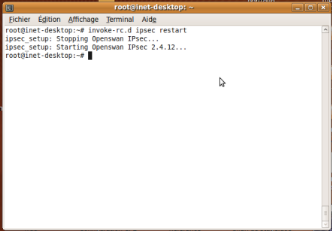III-2 Installation et
configuration du serveur OPENSWAN
Nous utiliserons ici un serveur basé sur une
distribution UBUNTU avec deux interfaces réseaux (eth0 =
IPprivée) et (eth1 = IPlan). Le L.A.N est adressé en
10.1.1.0/24.
- apt-get update
On commence par mettre à jour la base de données
des paquets UBUNTU.
- On installe le paquet openswan.
apt-get install openswan
- On fait une copie du fichier de configuration
« /etc/ipsec.d/examples/l2tp-psk.conf »
cp /etc/ipsec.d/examples/l2tp-psk.conf /etc/ipsec.d/l2tp-psk.conf
- On édite le fichier «
/etc/ipsec.d/l2tp-psk.conf »
Vi /etc/ipsec.d/l2tp-psk.conf
|
conn L2TP-PSK-noNAT
# Configuration for one user with any type of IPsec/L2TP
client
# including the updated Windows 2000/XP (MS KB Q818043), but
# excluding the non-updated Windows 2000/XP.
# Use a Preshared Key. Disable Perfect Forward Secrecy.
# PreSharedSecret needs to be specified in /etc/ipsec.secrets
as
# YourIPAddress %any: "sharedsecret"
authby=secret
pfs=no
auto=add
keyingtries=3
# we cannot rekey for %any, let client rekey
rekey=no
type=transport
left=192.168.1.64
# or you can use: left=YourIPAddress
# For updated Windows 2000/XP clients,
# to support old clients as well, use leftprotoport=17/%any
leftprotoport=17/1701
# The remote user.
right=%any
# Using the magic port of "0" means "any one single port".
This is
# a work around required for Apple OSX clients that use a
randomly
# high port, but propose "0" instead of their port.
rightprotoport=17/0
|
- On édite le fichier
« /etc/ipsec.conf »
Vi /etc/ipsec.conf
|
# /etc/ipsec.conf - Openswan IPsec configuration file
# RCSID $Id: ipsec.conf.in,v 1.15.2.6 2006-10-19 03:49:46 paul
Exp $
# This file: /usr/share/doc/openswan/ipsec.conf-sample
# Manual: ipsec.conf.5
version 2.0 # conforms to second version of ipsec.conf
specification
# basic configuration
config setup
# plutodebug / klipsdebug = "all", "none" or a combation from
below:
# "raw crypt parsing emitting control klips pfkey natt x509
private"
# eg: plutodebug="control parsing"
# ONLY enable plutodebug=all or klipsdebug=all if you are a
developer !!
# NAT-TRAVERSAL support, see README.NAT-Traversal
nat_traversal=yes
#
virtual_private=%v4:10.0.0.0/8,%v4:192.168.0.0/16,%v4:172.16.0.0/12
# enable this if you see "failed to find any available
worker"
nhelpers=0
# Add connections here
# sample VPN connections, see /etc/ipsec.d/examples/
#Disable Opportunistic Encryption
include /etc/ipsec.d/examples/no_oe.conf
include /etc/ipsec.d/l2tp-psk.conf
|
- On modifie le fichier
« /etc/ipsec.secret »
Vi etc/ipsec.secret
|
# RCSID $Id: ipsec.secrets.proto,v 1.3.6.1 2005-09-28 13:59:14
paul Exp $
# This file holds shared secrets or RSA private keys for
inter-Pluto
# authentication. See ipsec_pluto(8) manpage, and HTML
documentation.
# RSA private key for this host, authenticating it to any
other host
# which knows the public part. Suitable public keys, for
ipsec.conf, DNS,
# or configuration of other implementations, can be extracted
conveniently
# with "ipsec showhostkey".
192.168.1.64 %any: PSK "mypassword"
|
invoke-rc.d ipsec restart
Nous pouvons à présent redémarrer le service
IPSEC.
Nous devons obtenir le résultat suivant si tout c'est bien
passé :

netstat -antu
À ce stade, notre serveur VPN doit être à
l'écoute sur le port 500/udp et 4500/udp pour les connexions. Nous
pouvons le vérifier en utilisant la commande :
Nous pouvons aussi vérifier si la partie IPSEC des choses
fonctionne correctement, mais pour le faire nous seront obligé de
configurer à ce stade un client VPN sous Microsoft Windows. Dans le
souci de respecter les étapes prévues pour la rédaction de
ce mémoire nous le ferons bien après.
- On installe le paquet XL2TP
apt-get install xl2tpd
Modifier le fichier :
« /etc/xl2tpd/xl2tpd.conf »
Vi /etc/xl2tpd/xl2tpd.conf
|
[global]
listen-addr =192.168.1.64
[lns default]
ip range = 192.168.1.10-192.168.1.20
local ip = 192.168.1.5
require chap = yes
;refuse chap = yes
refuse pap = yes
require authentication = yes
ppp debug = yes
pppoptfile = /etc/ppp/options.xl2tpd
|
- Modifier le
fichier « /etc/ppp/options » de la sorte :
cp /etc/ppp/options /etc/ppp/options.xl2tpd
- Editer le
fichier : « /etc/ppp/options.xl2tpd »
Vi etc/ppp/options.xl2tpd
|
ipcp-accept-local
ipcp-accept-remote
ms-dns 192.168.1.4
ms-dns 209.212.96.1
noccp
auth
crtscts
idle 1800
mtu 1410
mru 1410
nodefaultroute
debug
lock
proxyarp
connect-delay 5000
silent
|
On modifier le fichier
« /etc/ppp/chap-secrets »
Vi /etc/ppp/chap-secrets
|
# Secrets for authentication using CHAP
# client server
secret IP addresses
inet * "consulting" 10.1.1.0/24
*inet «consulting» 10.1.1.0/24
|
| 


